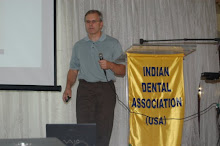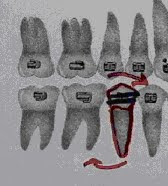Right Left
Answer: Yes you do reposition brackets based on root position as viewed on on the panorex as well as (on premolars and molars) marginal ridge heights as viewed in the mouth. Ideal bracket positioning results in slight distal inclination of all the roots. In this case, I would reposition both upper lateral brackets because both roots are mesially inclined. By aligning the long axis of the bracket with the pulp canal (rotate both brackets disto-gingivally) distal root inclination will be accomplished. Also, the upper 1st premolar roots need more distal inclination and, on the lower, both lower 5's and the lower right 2 need more distal root inclination. After repositioning, use 016niti for a month to align the repositioned brackets. After aligning is accomplished, continue with mechanics. Here is a way to help position brackets correctly: At the repositioning appointment, take a panorex to check for incorrectly positioned brackets. Evaluate root position (also called 2nd order position), and reposition the brackets to improve root position. Also check posterior marginal ridge height and reposition brackets to obtain level marginal ridges. Repositioning is time consuming and difficult, but correcting 2nd order inclination will result in much better occlusion. Root inclination is the main focus of repositioning because 2nd order arch wire bends are difficult to make. When repositioning, first identify teeth with incorrect root inclination. Reposition the brackets on those teeth so the long axis of the bracket is parallel to the pulp canal. Ideally, brackets should be checked (and repositioned, if necessary) twice during treatment. The first repositioning is done after the wire progression is complete (usually about 7 to 10 months into treatment) and the second repositioning is done at the start of finishing (usually about 4 months before removal). Look at the x-ray below and evaluate root position. Is there a method to quickly determine how to position brackets to achieve optimal root position? Fortunately, there is. Focus on the inclination of the bracket slot. If distal root movement is needed, angle the bracket slot disto-gingivally, and if mesial root movement is needed, angle the slot meso-gingivally. Look at the example below.
The outlined tooth (red) represents the current root position. To tip the root to the distal, change the inclination of the bracket slot so it is angled disto-gingivally.
Here is how a correctly positioned
Notice how changing the slot inclination changes how the root will be positioned. (Thanks to Gerry Samson, for allowing the use of these photos. You can find more information about Gerry’s CE courses at www.gnathosce.com .






